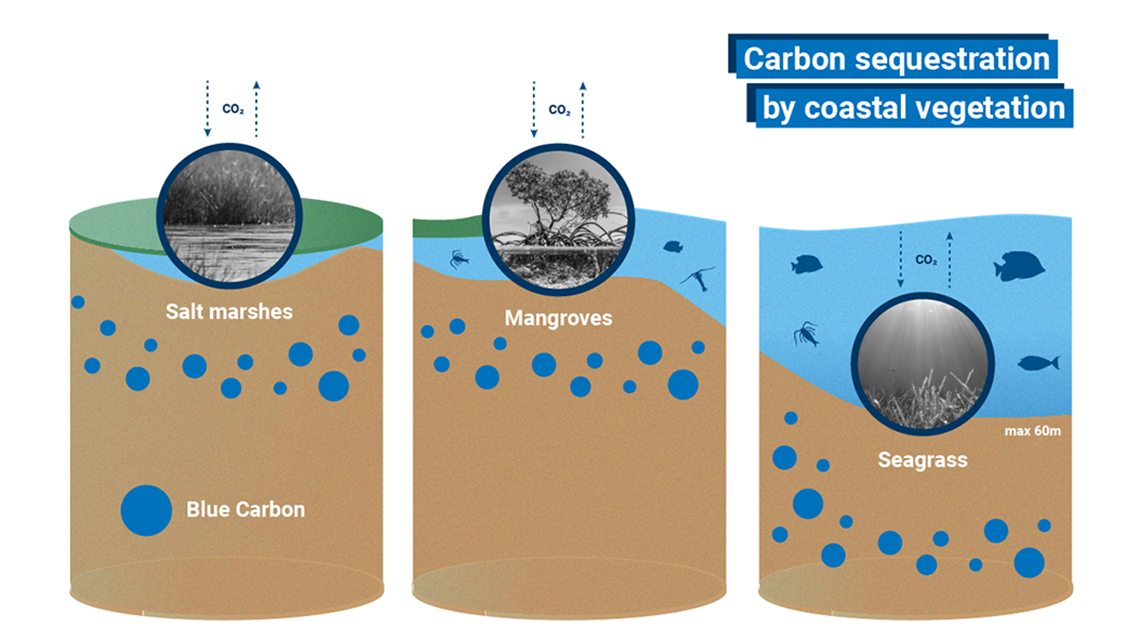Carbon absorption by coastal vegetation
Blue Carbon refers to organic carbon captured and stored by the ocean in vegetated coastal ecosystems such as mangrove forests, saltmarshes or seagrass meadows. In these Blue Carbon ecosystems, organic carbon accumulates in sediment where it is stored. These ocean habitats are spread along our coasts, can be found on every continent except Antarctica and cover approximately 50 million hectares - a territory almost double the size of the United Kingdom.
Blue Carbon ecosystems have the potential to help people and coastal environments mitigate and adapt to climate change.
This is not only because coastal ecosystems can sequester large amounts of carbon, they also play an important role in protecting coastlines from erosion and reducing the impacts of storm surges and rising sea-levels. Vegetation growing in coastal areas can help improve water quality by filtering pollutants; support biodiversity by providing habitat for a variety of species; and serve as nurseries for fish and shellfish. These factors show how vegetated coastal ecosystems help make people and communities more resilient in the face of climate change and related severe weather events, both by protecting coastal areas from climate change-related weather events and by helping protect marine life.

Organic carbon (C) is captured by coastal ecosystems organisms' roots, stems, and leaves of plants. (Infographic: A. Huescar Barber/IAEA)
Blue Carbon ecosystems help sustain the environment by mitigating climate change. Conversely, destroying and eroding coastal areas storing Blue Carbon could lead to the release of large quantities of sequestered carbon back to the atmosphere over a short period of time.
Scientists agree that the capacity of Blue Carbon ecosystems to sequester carbon has been drastically reduced over the past 70 years as a result of unsustainable coastal development, deforestation, environmental pollution and other destructive activities. In the last 50 years, the area covered by vegetated coastal habitat has shrunk between 25 and 50 per cent.
The ocean carbon cycle
How do coastal ecosystems act as a carbon sink?
Billions of tonnes of carbon are constantly moving through the atmosphere, land and oceans. The ocean carbon cycle is a set of vital processes that helps regulate the Earth's climate and support sustainable marine life.
Carbon sequestration occurs when carbon is removed from the carbon cycle and stored in marine sediment for long periods of time.
What can nuclear science do?
Sediment that accumulates in the seagrasses, mangroves and marshes can be analysed to help indicate changes in the environment over periods of time, ranging from the past few years to millions of years ago. The capacity of vegetated coastal ecosystems to sequester and store carbon in their sediments can be measured by nuclear and isotopic techniques.
The IAEA Marine Environment Laboratories in Monaco use these elements to determine the rates at which organic carbon accumulates in marine sediments using sediment core samples from vegetated coastal ecosystems. Sediment cores are collected by using long plastic tubes that during sampling are able to preserve the layers of sediment accumulated over time.
The naturally occurring radioactive isotope lead-210 (210Pb), in combination with some artificial radionuclides such as caesium-137 (137Cs) are used to determine the sedimentation rates in the sediments at timescales of decades - up to around 100 years, a period during which human induced impacts on the environment have dramatically increased.
These techniques encompass radiochemical separation and measurements by alpha and gamma spectrometry adapted to each isotope. This is then combined with the measurement of organic carbon contents and its isotopes along the sedimentary record by mass spectrometry methods to assess the organic carbon stocks and burial rates.
How can Blue Carbon be used as a nature-based climate solution?
Blue Carbon can help to fight climate change by removing excess carbon from the atmosphere and storing it for hundreds or thousands of years. However, this very capacity to sequester carbon makes it imperative that these ecosystems are protected and preserved. When we damage these coastal habitats, the carbon previously stored is released, leading to further negative impacts.
Investing in Blue Carbon is investing in a future where nature helps to slow the impacts of climate change and policymakers use evidence-based data to support the sustainable management of the ocean and coastal vegetated ecosystems. Protecting these areas means healthier coasts, healthier ecosystems and a healthier planet.
What is the role of the IAEA?
- The IAEA's Marine Environment Laboratories apply nuclear and isotopic techniques to better understand the carbon cycle and evaluate the potential capacity of vegetated coastal ecosystems to store carbon.
- The Laboratories focus on researching marine and coastal ecosystems, biodiversity loss, ocean acidification and accumulation of trace elements and other pollutants in marine ecosystems.
- The Agency is involved in projects to assess the rates of carbon sequestration in vegetated coastal areas and to aid in data collection in more than 40 countries.
- The IAEA supports European, Asia-Pacific, Latin American and Caribbean and African countries to train scientists and build capacity to accurately measure carbon sequestration rates in Blue Carbon ecosystems.
- The Agency helps its Member States to evaluate potential environmental and socio-economic impacts of changes in ecosystems and implications for sustainable food security.
- The IAEA also works to raise awareness of other ocean-based climate changes, including ocean acidification, which occurs as a result of excess CO2 concentrations in ocean water, through its Ocean Acidification International Coordination Centre (OA-ICC).








